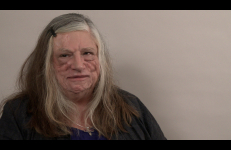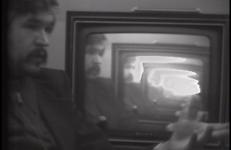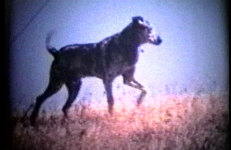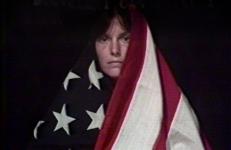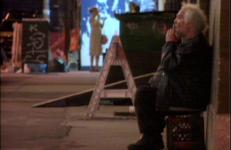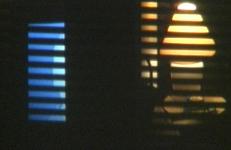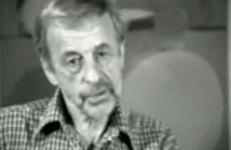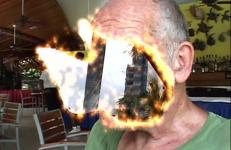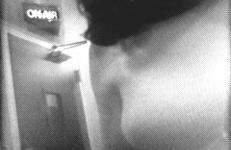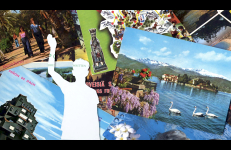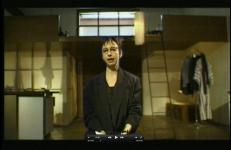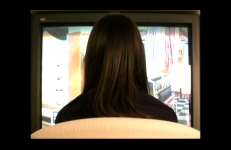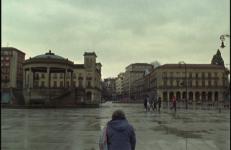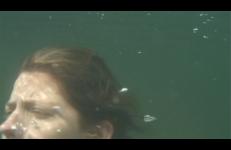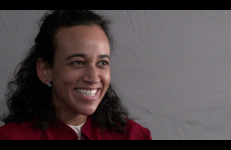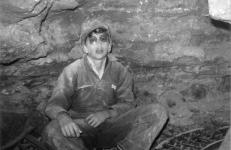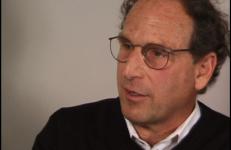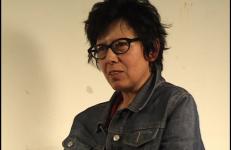An architect and urban planner by training, Dara Birnbaum began using video in 1978 while teaching at the Nova Scotia College of Art and Design, where she worked with Dan Graham. Recognized as one of the first video artists to employ the appropriation of television images as a subversive strategy, Birnbaum recontextualizes pop cultural icons (Technology/Transformation: Wonder Woman, 1978-79) and TV genres (Kiss the Girls: Make them Cry, 1979) to reveal their subtexts.
Film or Videomaking
A major figure among underground filmmakers, Stan Brakhage (1933-2003) boasted a prolific career that spanned more than 50 years and 300 films. His personal, independent films range in length from nine seconds to several hours, and contemplate such fundamental issues as form, life, and death—most famously in Window Water Baby Moving (1959), Dog Star Man (1961-65), and The Act of Seeing with One’s Own Eyes (1971). His early writings and journals about filmmaking are collected in Metaphors on Vision (1976).
Take a peek at scenes extracted from a videomaker's life. See him amid the glittering domain of glamour being given an award for his work visual work. Meet some of his family, including the "furry ones" – (his cats and rainbow coated dog), and stroll along with him into the deep woods at twilight.
In this interview video and performance artist Nancy Buchanan discusses her feminist and political work. Buchanan comments upon the advantages of video over performance in terms of accessibility—the ability for her videos to circulate and reach audiences she physically cannot, and their brevity and completed form—and her strategies to create an atmosphere for change. This Video Portrait features two of Buchanan’s videos in their entireties: the anti-nuclear weapons work An End to All Our Dreams (1982) and the more straightforwardly feminist Webs (1983).
DIRECTOR’S STATEMENT/SUMMARY: This film centers around one performance, when Holland-based musicians, The Ex, visited New York to play a concert. This performance is intercut with city scenes, first from Amsterdam and then New York, of construction sites, street life, and protests against the Iraq war and the Bush administration. The construction site scenes relate to the band's dedication to music as a realm for collaborative building and creative destruction.
"...a rumination, a series of borrowed 'dialogues' out of an ongoing argument with myself. It meanders, mentally and physically, reflecting on the conditions of being human; on transience, consciousness and desire. It uses landscapes as provocations, as sites of contemplation. And between the landscape and the thought, i.e. between the radical presence of the physical world and the idea, there is, more often than not, a distance, disbelief or irony."
–– Ken Kobland
Rudy Burckhardt (1914-1999) was best known as a photographer and filmmaker. He moved to New York from his native Basel in 1935 at age 21. He shot portraits of many artists for Art News during the 1950s and early ’60s, capturing their work methods in candid and intimate photos. His films, frequently portraying cityscapes and urban life, include The Pursuit of Happiness (1940), Under the Brooklyn Bridge (1953), What Mozart Saw on Mulberry Street (1956), Square Times (1967), and Inside Dope (1971).
This video diary/travelogue centers on a tropical trip to Acapulco where yours truly hits both sand and surf with maximum impact. The actual movie that's being documented throughout this video bit the dust via a hard-drive malfunction, so this is almost all that remains (so far) of the doomed yet enjoyable venture. We all donned bathing suits and splashed our way through heaven and hell as Miguel Calderon directs the cursed venture in skimpy attire amid other scantily clad examples of electro-graphic expertise.
The Videofreex had several experiences with the Black Panther Party, including interviewing Illinois Chapter Deputy Chairman Fred Hampton and New Haven Minister of Information Cappy Pinderhughes. In this tape, recorded on March 5th 1971, the Videofreex one-person camera crew Bart Friedman is walking the hallways of CBS, trying to find out where a video statement by Black Panther Eldridge Cleaver is located. The shots are mostly close up on people’s torsos and there is some image loss, but the sound is intact. The tape has an eerie espionage feel.
My contribution to the group exhibition 1d for Abroad at Tintype gallery: a perky 4 minute consideration (made up) of a whole lot of postcards.
A rising moon and lowering standards in secular shenanigans highlight this documentary on the making of a sci-fi epic for mini-adults. The stakes are high and the porkchops well done as cast and crew blast off to kiddie dimensions only dreamed of by reformed perverts who revert back to more primitive states of fetishistic attire to usher in the new millenium.
A pile-up of events pertaining to cinematic expositions begins its whirlwind of activity in the south and then moves west with the sun to the “golden state” for all that glitters on a silver screen. Along the way we find a cast of characters befitting the halls of any art asylum in need of talented inmates. Rich and poor lend their support to a medium that entombs our tribal dreams in a cocoon of luminous filaments that ignite projection lamps statewide so that the darkness be not so blinding (whatever the hell that means?).
Circle's Short Circuit is an experimental feature-length work with neither a beginning nor an end—the film can be viewed from any random point. It moves through a circle of five interlocking episodes that describe the phenomenon of interruption in contemporary communication through various forms and modes, investigating causes, consequences, and side-effects. Genres shift along the episodic path of this circle, moving from documentary to essay, through collage, simulated live-coverage, and silent film.
In this 2006 interview, filmmaker Jem Cohen discusses his early interest in art, his family’s welcome antipathy towards commercialization, and his unconventional, anti-mainstream film practice. In particular, Cohen discusses his film This is a History of New York, and how this piece exemplifies his interest in the “territory of sensation” rather than simple visual descriptiveness. Cohen concludes by discussing the role of archiving in his practice, and how compulsive documentation of the quotidian and unexceptional can result in the empowerment of the everyday.
A video about the conception of video and of life itself. This work suggests that all that is conceived transcends the division between the external and interior worlds.
In Portuguese with English subtitles.
In this conversation, Cathy Lee Crane (b. 1962) talks about her experience working with Harun Farocki on the groundbreaking video I Thought I Was Seeing Convicts (2000) and how the collaboration has informed her practice as a film and video maker. Crane also discusses the artistic approach and strategies that she takes when interacting with correctional institutions in the United States.
A portrait of Luce Vigo, film critic, educator, and the daughter of pivotal French filmmaker Jean Vigo. Commissioned by the Spanish documentary festival, Punto de Vista, the film incorporates Luce's memories of her extraordinary life, reflections on her father, and images of Northern Spain.
In this video, made soon after the death of his mother Stella, we accompany George to the wake, and on to a trip to Albert Maysles holiday home on Fisher's Island.
"Deep waters flow around the living, dead and inanimate objects that bring this picture to life on the wide screen tapestry of electronic reality. Come and join the young and old of eastern energies as they bask in the sun and shadows of past sins and future fortunes. See how the other side lives and devours the fruits and nuts that pepper this great nation with neon nutrients worthy of Broadway and beyond!"
After the screening of his film Wai'á rini, the power of dream in other Xavante villages, the people of Aldeia Nova from the São Marcos reservation asked Divino to make a film on the same ritual, the Wai'á ceremony. In this ceremony the young men are initiated into the spiritual world to develop their curative power. This is a new experience for Divino, as he has to shoot in a different village, but also find a way to try new tricks and to develop his editing skills.
Various languages.
Direction and photography: Divino Tserewahú
Susan Mogul's fantasies of success have always a comic, congenial twist, as in Dear Dennis, a video letter to Dennis Hopper inspired by her discovery that they share the same dentist. The central irony of this witty piece is that, despite Hopper's popular persona as an innovative, sub-cultural filmmaker and performer, the actual distance between his so-called independent" films and Mogul's experimental, non-commercial videos prevents Susan from finding any common ground from which to address Hopper other than the subject of dental work.
Like a generation of viewers, I was profoundly affected by Deliverance. But I have always been troubled by the hegemonic structures of gender proposed by Boorman and Dickey. Hence, my version is played by women: myself, Peggy Ahwesh, Jackie Goss, Su Friedrich, and Meredith Root, all experimental filmmakers who work as academics. While faithful to our respective male characters, we also play ourselves.
Nazlı Dinçel’s hand-made work reflects on experiences of disruption. They record the body in context with arousal, immigration, dislocation and desire with the film object: its texture, color and the tractable emulsion of the 16mm material. Their use of text as image, language and sound imitates the failure of memory and their own displacement within a western society. Born in Ankara, Turkey, Dinçel immigrated to the United States at age 17. Dinçel resides in Milwaukee, WI where they are currently building an artist run film laboratory.
The Disappointment: Or, The Force of Credulity is a documentary about the search for four lost treasures buried on a single farm in Missouri. These treasures include a Spanish explorer's gold, silver from the Civil War, mysterious stone carvings, lost texts, and a wife's attempt to heal her husband and protect herself and her children. Part personal documentary and part historical essay, The Disappointment traces the patterns of cultural forgetting etched in the landscape of the Austin Farm.
Nathaniel Dorsky’s films are precise articulations of cinematic qualities: the surprise of an edit, the composition of framing, and the flash of the image. Dubbed the “filmmaker’s filmmaker”, Dorsky’s work captures the fleeting moments of everyday life in its poetic chaos in such films as Pneuma (1976-82), Triste (1974-96), Alaya (1976-87), and Variations (1992-98). Using a spring-wound Bolex and 16mm reversal stock film, Dorsky’s films operate in the realm of the purely visual.
In this interview Cecilia Dougherty describes her work and her explorations into family interactions, outsider psychology, role-playing, lesbian sexuality, and popular culture. Her videos Grapefruit (1989) and Coal Miner’s Granddaughter (1991) work from within mass culture norms to create a lesbian dialogue within the “normal”—what Dougherty calls “the life of the ordinary lesbian and her working-class family.” Her more recent vides explore lesbian identity within a separate social sphere.




